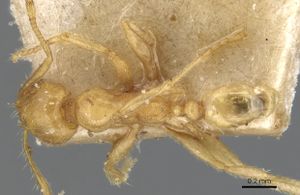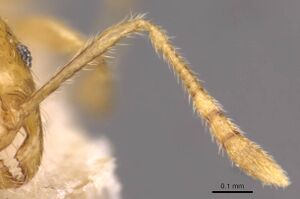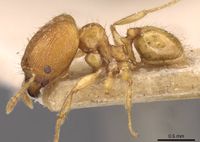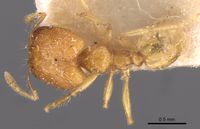Pheidole butteli
| Pheidole butteli | |
|---|---|

| |
| Scientific classification | |
| Kingdom: | Animalia |
| Phylum: | Arthropoda |
| Class: | Insecta |
| Order: | Hymenoptera |
| Family: | Formicidae |
| Subfamily: | Myrmicinae |
| Tribe: | Attini |
| Genus: | Pheidole |
| Species: | P. butteli |
| Binomial name | |
| Pheidole butteli Forel, 1913 | |
This species inhabits well-developed forests in lowlands and hill areas. Two colonies each (Eg97-BOR-524, Eg99-BOR-085) included at least two dealate queens. (Eguchi 2001a) Heterick & Kitching (2022) collected this species in a pitfall trap and in the canopy of a lowland dipterocarp forest in Brunei.
Identification
Eguchi (2001a) - This species is recognised among Indo-Malayan congeners by a combination of the following characteristics: hypostoma of the major bearing three median processes; frontal carina of the major inconspicuous; promesonotal dome highly raised in the major; lower part of mesopleuron margined dorsally in the major; head and promesonotum of the minor smooth and shining. P. butteli is separated from the most similar Pheidole tawauensis in which frontal lobe of the major is relatively large and erect, and occipital carina of the minor is stronger.
Keys including this Species
- Key to Pheidole majors and minors of Borneo
- Key to Pheidole majors of Borneo
- Key to Pheidole minors of Borneo
Distribution
Latitudinal Distribution Pattern
Latitudinal Range: 4.95° to 4.95°.
| North Temperate |
North Subtropical |
Tropical | South Subtropical |
South Temperate |
- Source: AntMaps
Distribution based on Regional Taxon Lists
Indo-Australian Region: Borneo, Brunei Darussalam, Indonesia (type locality), Malaysia.
Oriental Region: Thailand.
Distribution based on AntMaps
Distribution based on AntWeb specimens
Check data from AntWeb
Countries Occupied
| Number of countries occupied by this species based on AntWiki Regional Taxon Lists. In general, fewer countries occupied indicates a narrower range, while more countries indicates a more widespread species. |

|
Estimated Abundance
| Relative abundance based on number of AntMaps records per species (this species within the purple bar). Fewer records (to the left) indicates a less abundant/encountered species while more records (to the right) indicates more abundant/encountered species. |

|
Biology
Castes
Worker
Images from AntWeb
   
| |
| Syntype of Pheidole butteli. Worker. Specimen code casent0904249. Photographer Will Ericson, uploaded by California Academy of Sciences. | Owned by MSNG, Genoa, Italy. |
    
| |
| Paralectotype of Pheidole butteli. Worker. Specimen code casent0907865. Photographer Will Ericson, uploaded by California Academy of Sciences. | Owned by MHNG, Geneva, Switzerland. |
Nomenclature
The following information is derived from Barry Bolton's Online Catalogue of the Ants of the World.
- butteli. Pheidole butteli Forel, 1913k: 36 (s.w.q.m.) INDONESIA (Sumatra). See also: Eguchi, 2001a: 6; Eguchi, 2001b: 39.
Unless otherwise noted the text for the remainder of this section is reported from the publication that includes the original description.
Description
Worker
Eguchi (2001a) - Major (n=6): TL 2.0-2.4 mm, HL 0.88-1.02 mm, HW 0.76-0.87 mm, SL 0.42-0.48 mm, FL 0.55-0.64 mm, CI 82-88, SI 53-59, FI 70-78. Head broadest about 1/2-2/3 distance of head (as measured from the mid-point of a transverse line spanning the anteriormost and posteriormost projecting points, respectively) (Fig. 9A), in profile not or slightly impressed on vertex (Fig. 9B). Hypostoma bearing three median processes (Fig. 9C). Clypeus without a median longitudinal carina, with anterior margin weakly emarginate medially. Eye situated at about 1/3 distance of head; distance between mandibular insertion and anterior margin of eye 1.4-1.6 times as long as maximal diameter of eye. Frontal carina almost absent, or inconspicuous and extending backward to about 2/3 of head. Antennal scrobe present only around antennal insertion. Antenna with 3-segmented club; scape extending backward to about midlength of head, or slightly beyond there; terminal segment 1.1-1.2 times as long as preceding two segments together. Masticatory margin of mandible with apical and preapical teeth, and a denticle in front of basal angle. Promesonotum forming a high dome, with an inconspicuous prominence on its posterior declivity (Fig. 9D); each dorsolateral portion of the dome weakly produced outward. Mesopleuron sometimes divided by a weak transverse impression into two parts, of which lower part is margined dorsally. Propodeal spine triangular or horn-like, 2-2.5 times as long as diameter of propodeal spiracle. Petiole 1.6-1.8 times as long as postpetiole (excluding he1cium); petiolar node in posterior view hardly or not emarginate at apex. Postpetiole 1.7-1.8 times as broad as petiolar node.
Dorsum of head excluding occipital lobe longitudinally rugose, with smooth and shining interspaces; dorsal and dorsolateral faces of occipital lobe reticulate or rugoso-reticulate, with enclosures smooth and shining or very weakly punctured; lateral face of occipital lobe weakly rugosoreticulate; dorsum of promesonotal dome largely smooth and shining, or very weakly sculptured; anterior and lateral faces of the dome largely smooth and shining; remainder of alitrunk and waist weakly punctured at least partly; first gastral tergite weakly punctured around its articulation with postpetiole. Outer face of mandible sparsely covered with appressed hairs, which are 0.02-0.05 mm in length and shorter than distance between piligerous punctures; submarginal zone of masticatory margin of mandible with a row of longer decumbent hairs. Body brown to reddish-brown, with a little darker gaster; flagella and legs a little lighter than alitrunk.
Minor (n=5): TL 1.4-1.6 mm, HL 0.45-0.50 mm, HW 0.39-0.43 mm, SL 0.43-0.50 mm, AL 0.62-0.69 mm, FL 0.46-0.54 mm, CI 84-89, SI 104-119, FI 114-129. Head in full-face view narrowed behind eye, with almost flat or weakly concave posterior margin (Fig. 9E); occipital carina evanescent dorsally on head. Clypeus without a median longitudinal carina, with anterior margin in full-face view slightly convex medially. Eye situated just in front of midlength of head; distance between mandibular insertion and anterior margin of eye 0.8-0.9 times as long as maximal diameter of eye. Frontal carina and antennal scrobe present only around antennal insertion. Antenna with 3-segmented club; in full-face view scape extending beyond posterior border of head by its 1/5 length; terminal segment ca. 1.1 times as long as preceding two segments together. Promesonotum convex, without any prominence on its posterior declivity (Fig. 9F). Mesopleuron sometimes with a transverse impression. Propodeal spine 1.5-2 times as long as diameter of propodeal spiracle. Petiole ca. 1.8 times as long as postpetiole (excluding helcium); petiolar node in posterior view not emarginate at apex. Postpetiole in dorsal view subhexagonal, 1.4-1.6 times as broad as petiolar node.
Head including clypeus and promesonotum smooth and shining; remainder of alitrunk weakly punctured at least partly; lateral face of petiole weakly punctured; dorsum of petiole, and postpetiole and gaster smooth and shining. Body yellowish-brown (alitrunk sometimes a little lighter than head and gaster); antennae and legs a little lighter than alitrunk.
Type Material
Eguchi (2001b) - major, minor, queen and male; Tandjong Slamat, Sumatra. Six syntypes (3 majors and 3 minors, Musee d'Histoire Naturelle Genève) were examined, of which one major is designated as the lectotype.
References
- Eguchi, K. 2001a. A revision of the Bornean species of the ant genus Pheidole (Insecta: Hymenoptera: Formicidae: Myrmicinae). Tropics Monograph Series. 2:1-154.
- Eguchi, K. 2001b. A taxonomic study on Asian Pheidole (Hymenoptera, Formicidae): new synonymy, rank changes, lectotype designations and redescriptions. Insecta Koreana. 18:1-35.
- Cantone S. 2017. Winged Ants, The Male, Dichotomous key to genera of winged male ants in the World, Behavioral ecology of mating flight (self-published).
- Forel, A. 1913l. Wissenschaftliche Ergebnisse einer Forschungsreise nach Ostindien ausgeführt im Auftrage der Kgl. Preuss. Akademie der Wissenschaften zu Berlin von H. v. Buttel-Reepen. II. Ameisen aus Sumatra, Java, Malacca und Ceylon. Gesammelt von Herrn Prof. Dr. v. Zool. Jahrb. Abt. Syst. Geogr. Biol. Tiere 36: 1-148 (page 36, soldier, worker, queen, male described)
- Heterick, B.E., Kitching, R.L. 2022. The ants (Hymenoptera: Formicidae) of a one-hectare plot of lowland dipterocarp forest. Entomologist’s Monthly Magazine 158(4), 261–272 (doi:10.31184/m00138908.1584.4153).
- Khachonpisitsak, S., Yamane, S., Sriwichai, P., Jaitrong, W. 2020. An updated checklist of the ants of Thailand (Hymenoptera, Formicidae). ZooKeys 998, 1–182 (doi:10.3897/zookeys.998.54902).
- Wang, W.Y., Soh, E.J.Y., Yong, G.W.J., Wong, M.K.L., Benoit Guénard, Economo, E.P., Yamane, S. 2022. Remarkable diversity in a little red dot: a comprehensive checklist of known ant species in Singapore (Hymenoptera: Formicidae) with notes on ecology and taxonomy. Asian Myrmecology 15: e015006 (doi:10.20362/am.015006).
References based on Global Ant Biodiversity Informatics
- Chapman, J. W., and Capco, S. R. 1951. Check list of the ants (Hymenoptera: Formicidae) of Asia. Monogr. Inst. Sci. Technol. Manila 1: 1-327
- Eguchi K. 2001. A revision of the Bornean species of the ant genus Pheidole (Insecta: Hymenoptera: Formicidae: Myrmicinae). Tropics Monograph Series 2: 1-154.
- Eguchi K. 2001. A taxonomic study on Asian Pheidole (Hymenoptera, Formicidae): new synonymy, rank changes, lectotype designations and redescriptions. Insecta Koreana 18: 1-35.
- Eguchi K., S. Yamane, and S.Y. Zho. 2007. Taxonomic revision of the Pheidole rinae Emery complex. Sociobiology 50 (1): 275-284.
- Eguchi K., and S. Yamane. 2003. Species diversity of ants (Hymenoptera, Formicidae) in a lowland rainforest, northwestern Borneo. New Entomol. 52(1,2): 49-59.
- Forel A. 1913k. Wissenschaftliche Ergebnisse einer Forschungsreise nach Ostindien ausgeführt im Auftrage der Kgl. Preuss. Akademie der Wissenschaften zu Berlin von H. v. Buttel-Reepen. II. Ameisen aus Sumatra, Java, Malacca und Ceylon. Gesammelt von Herrn Prof. Dr. v. Buttel-Reepen in den Jahren 1911-1912. Zoologische Jahrbücher. Abteilung für Systematik, Geographie und Biologie der Tiere 36:1-148.
- Herwina H., and K. Nakamura. 2007. Ant species diversity study using pitfall traps in a small yard in Bogor Botanic garden, West Java, Indonesia. Treubia 35: 99-116.
- Ito, F.; Yamane, S.; Eguchi, K.; Noerdjito, W. A.; Kahono, S.; Tsuji, K.; Ohkawara, K.; Yamauchi, K.; Nishida, T.; Nakamura, K. 2001. Ant species diversity in the Bogor Botanic Garden, West Java, Indonesia, with descriptions of two new species of the genus Leptanilla (Hymenoptera, Formicidae). Tropics 10:379-404.
- Jaitrong W., and T. Ting-Nga. 2005. Ant fauna of Peninsular Botanical Garden (Khao Chong), Trang Province, Southern Thailand (Hymenoptera: Formicidae). The Thailand Natural History Museum Journal 1(2): 137-147.
- Jaitrong W.; Nabhitabhata, J. 2005. A list of known ant species of Thailand. The Thailand Natural History Museum Journal 1(1): 9-54.
- Pfeiffer M., and D. Mezger. 2012. Biodiversity Assessment in Incomplete Inventories: Leaf Litter Ant Communities in Several Types of Bornean Rain Forest. PLoS ONE 7(7): e40729. doi:10.1371/journal.pone.0040754
- Pfeiffer M., and D. Mezger. 2012. Biodiversity Assessment in Incomplete Inventories: Leaf Litter Ant Communities in Several Types of Bornean Rain Forest. PLoS ONE 7(7): e40729. doi:10.1371/journal.pone.0040986
- Pfeiffer M.; Mezger, D.; Hosoishi, S.; Bakhtiar, E. Y.; Kohout, R. J. 2011. The Formicidae of Borneo (Insecta: Hymenoptera): a preliminary species list. Asian Myrmecology 4:9-58
- Watanasit S., J. Saewai, and A. Philapplueng. 2007. Ants of the Klong U-Tapao Basin, Southern Thailand. Asian Myrmecology 1: 69-79.



